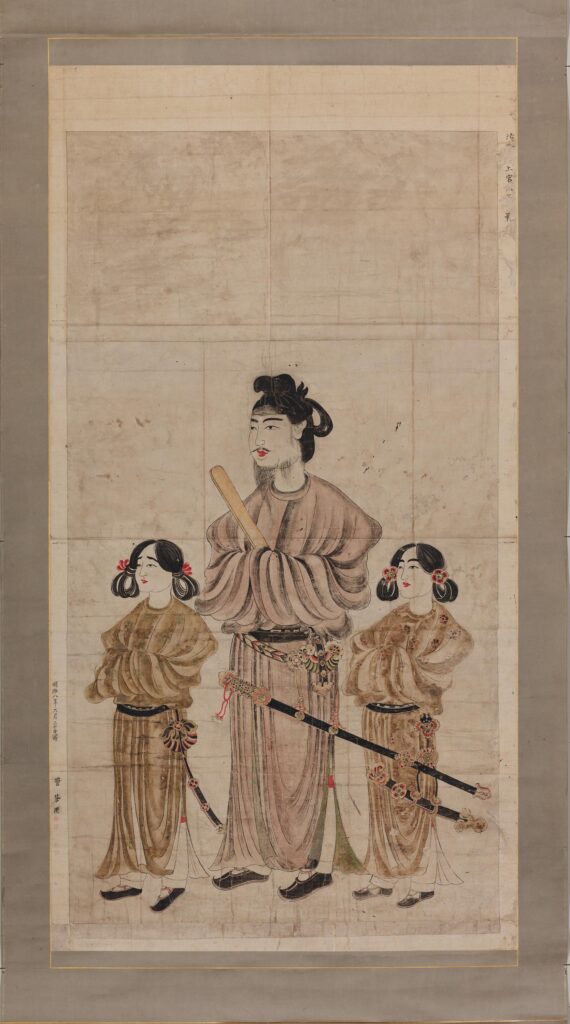

574-622
厩戸皇子
Umayado no Oji (Prince Umayado)
AKA Shōtoku Taishi (Prince Shotoku) 聖徳太子
The Enigmatic Statesman Who Shaped Japan’s Future
Mysterious Beginnings
Prince Umayado, born in 574 as the son of Emperor Yōmei, entered the world under a cloud of mystery. He became known as Shōtoku Taishi (Prince Shōtoku) after his death. Even the origins of his birth have sparked intriguing stories. One legend suggests his mother nearly gave birth to him outside a stable, while another claims he was born in a stable, evoking comparisons to figures of spiritual significance. As a child, Prince Umayado would not only witness but also quietly influence major political and religious shifts in Japan.
By the age of 13, Prince Umayado found himself in the midst of a war between two powerful noble families—the pro-Buddhist Soga clan and the anti-Buddhist Mononobe clan. The conflict was sparked by disputes over imperial succession and whether Japan should embrace the newly introduced Buddhism. Although Prince Umayado was too young to join the battlefield, he prayed for the Soga’s victory, promising to build a temple if they won. When the Soga triumphed, the iconic Shitennō-ji Temple was constructed in Osaka, marking the beginning of Prince Umayado’s lifelong promotion of Buddhism.
Navigating Political Chaos
Following the Soga clan’s victory, Japan’s political landscape remained turbulent. Emperor Sushun, who opposed the Soga clan, was assassinated, and Empress Suiko, Prince Umayado’s aunt, ascended the throne. She became Japan’s first female ruler, remembered for her wisdom and strength. While Suiko held the title of ruler, it was Prince Umayado who guided Japan’s political strategies as her regent. He implemented groundbreaking reforms that forever altered the country’s governmental structure.
The Twelve-Level Cap and Rank System: A Meritocracy Ahead of Its Time
At the time, Japan’s political hierarchy was based on heredity. Powerful families ruled the court through their bloodlines, leaving little room for individual merit. Prince Umayado sought to change this entrenched system. In 603, he introduced the Twelve-Level Cap and Rank System, categorizing officials based on their abilities rather than their family name. Different colored robes and caps signified each of the 12 ranks, starting with black for the lowest rank and progressing through white, yellow, orange, blue, and purple for the highest.
Prince Umayado’s meritocratic system was revolutionary, encouraging personal achievement and breaking the chains of nepotism. The rank names were drawn from Confucian virtues, underscoring Prince Umayado’s embrace of philosophical wisdom as a foundation for governance
The Seventeen-Article Constitution: Japan’s First Code of Ethics
A year later, in 604, Prince Umayado further cemented his legacy with the creation of Japan’s first constitution: the Seventeen-Article Constitution. Far more than a legal code, it served as a moral guide for Japan’s rulers and bureaucrats, blending Confucian and Buddhist teachings. Its most famous phrase, “Harmony is to be valued above all,” called for unity and cooperation among officials. Prince Umayado also implored leaders to avoid self-righteousness, declaring, “I am not necessarily a sage, and they are not necessarily fools. We are both ordinary people.”
This constitution discouraged bribery and emphasized the importance of making collective decisions—principles that resonate with modern ideas of ethical governance. Through this document, Prince Umayado aimed to foster not only a well-ordered state but also a society built on moral integrity.
The First Use of the Name “Japan”
In his quest to elevate Japan’s status on the global stage, Prince Umayado made a bold move that would change the nation’s identity. At that time, China’s powerful Sui dynasty viewed itself as the sole authority in East Asia. Japan, then called “Wa,” was seen as a distant, inferior kingdom. In 600, Prince Umayado sent the first diplomatic mission to the Sui court, but the emperor showed little interest.
Determined to assert Japan’s equality, Prince Umayado orchestrated a second mission in 607, led by Ono no Imoko. He sent a letter to the Sui emperor with the provocative statement: “The Son of Heaven in the land where the sun rises sends this letter to the Son of Heaven in the land where the sun sets.” By referring to Japan as the “land where the sun rises” and China as the “land where the sun sets,” Prince Umayado claimed equality with the Chinese emperor and introduced the concept of Japan (日本 Nihon), or the “origin of the sun.” Although the Sui emperor was angered by this declaration, Japan’s diplomatic relations with China continued, and Prince Umayado successfully set Japan on a path toward international recognition.
The Buddhist Visionary: Spreading Religion and Culture
Prince Umayado’s influence extended beyond politics and diplomacy. A devout Buddhist, he worked tirelessly to spread the religion across Japan. He commissioned the construction of many temples, including the renowned Hōryū-ji and Shitennō-ji, both of which remain cultural landmarks to this day. Prince Umayado believed in the power of Buddhism not only as a spiritual practice but also as a tool for cultural and intellectual advancement.
Under his leadership, Japan absorbed cultural influences from China, Korea, and even farther afield along the Silk Road. Artifacts such as half-seated Buddha statues (hanka-zō), with their gentle, contemplative smiles, testify to the blending of foreign artistic styles with Japanese aesthetics. These serene smiles, known as “Archaic Smiles,” resemble those found on Egypt’s Sphinx and Leonardo da Vinci’s Mona Lisa, linking Japanese artistry to the wider world.
Prince Umayado also introduced innovations such as calendars, paper, ink, and pigments, further aligning Japan with the technological advancements of the Asian continent. His commitment to preserving history led to the compilation of historical records like the Tennōki (天皇記) and Kokki (国記), which sought to legitimize the authority of the Japanese emperors.
Tragic End and the Rise of Legends
Prince Umayado’s remarkable life came to an end in 622, before the completion of his masterpiece, Hōryū-ji Temple. Although he did not live to see its final form, the temple stands as a testament to his devotion to Buddhism and his lasting impact on Japanese culture. However, his death marked the beginning of dark times for his family, as his descendants were later assassinated, bringing an abrupt and tragic end to his lineage.
Yet, the fall of his bloodline did nothing to stop the spread of his legend. Historical texts, such as the Nihon Shoki (日本書紀), described Prince Umayado as a near-mythical figure. He was said to possess extraordinary powers, including the ability to hear ten people speaking at once and respond to each one perfectly. Some stories even claimed he could speak from birth and foresee the future. While these tales are likely exaggerations, they reflect the deep admiration and reverence the Japanese people held for Prince Umayado.
A Legacy That Endures
Prince Umayado’s contributions to Japan’s political, cultural, and religious foundations are undeniable. His reforms shaped the nation’s governance for centuries, and his promotion of Buddhism left a lasting spiritual legacy. His vision of Japan as a culturally sophisticated and independent nation continues to inspire historians, scholars, and political leaders.
Though often shrouded in legend, Prince Umayado’s real achievements are profound. He was a thinker ahead of his time, crafting systems of governance, diplomacy, and culture that propelled Japan into a new era. His legacy as a symbol of wisdom, humility, and foresight ensures that his name endures as one of Japan’s most intriguing and influential figures.
.
.
.




